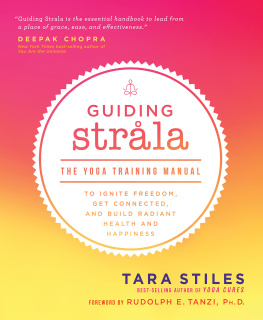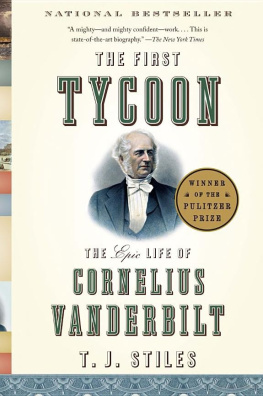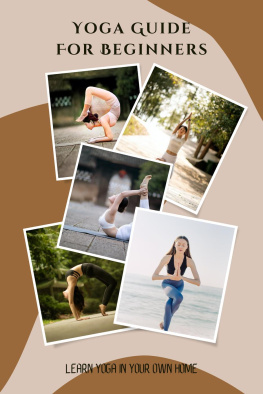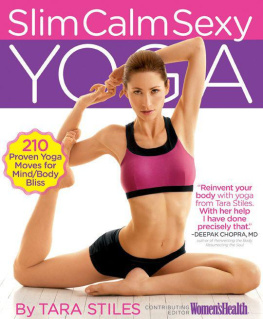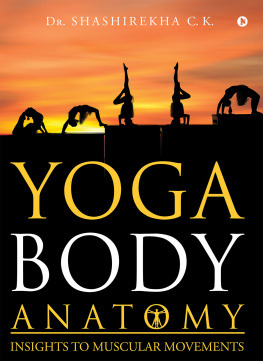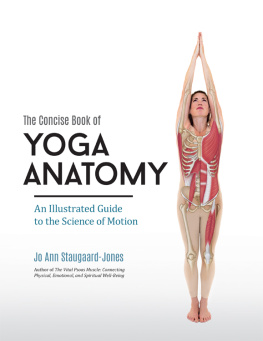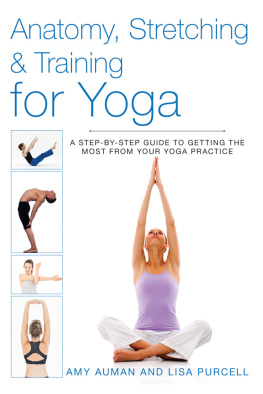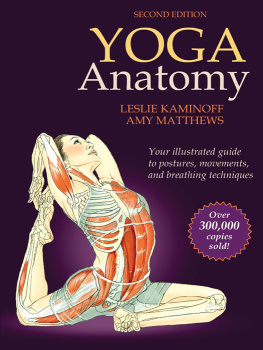

First published in 2000 by
Red Wheel/Weiser, LLC
with offices at:
500 Third Street, Suite 230
San Francisco, CA 94107
www.redwheelweiser.com
This hardcover edition, 2005
Copyright 2000 Mukunda Stiles
All rights reserved. No part of this publication may be reproduced or transmitted in any form or by any means, electronic or mechanical, including photocopying, recording, or by any information storage or retrieval system, without permission in writing from Red Wheel/Weiser, LLC.
Reviewers may quote brief passages.
SYMPTOMS OF INNER PEACE appearing on page 315 is excerpted, adapted, and reprinted by permission of Saskia Davis, LLC. All rights reserved by Saskia Davis, LLC, 10640 Exeter Ave. N. E., Seattle, WA 98125 (206) 363-8894 www.symptomsofinnerpeace.net
ISBN: 978-1-57863-177-3
Library of Congress Cataloging-in Publication Data
Stiles, Mukunda
Structural yoga therapy : adapting to the individual / Mukunda Stiles
p.cm.
Includes bibliographical references and index.
ISBN 1-57863-177-7 (hardcover : alk. paper)
ISBN 157863-209-9 (pbk. : alk. paper)
1. Yoga, HathaTherapeutic use. I. Title.
RM727.Y64 S75 2000
613.7046dc21
00-033471
Typeset in 11/13 Adobe Garamond
Cover and book design by Kathryn Sky-Peck
Illustration of Patanjali on part title pages used by permission of B. K. S. Iyengar.
Cover photography 2000 Photodisc, Inc.
PRINTED IN THE UNITED STATES OF AMERICA
MV
10 9 8
The paper used in this publication meets the minimum requirements of the American National Standard for Information Sciences-Permanence of Paper for Printed Library Materials Z39.48-1992 (R1997).
A Yogi's Prayer

May all who are mean return to good;
May all who are good obtain true peace.
May all who are peaceful be freed from bonds;
May all who are free set others free.
Blessings upon all the earth;
May all the world's rulers uphold righteousness.
May only good fortune reach everyone;
May all the world's creatures be happy.
May rain fall when the earth is thirsty;
May all the storehouses be filled.
May everyone here be free from injury;
May all who are good be free from fear.
May everyone know a life of joy;
May everyone live a life of health.
May everyone see only good in the world;
May everyone soon be released from pain.
May everyone overcome all their woes;
May everyone see only good in the world.
May everyone realize all their desires;
May everyone everywhere be glad.
May our mother and father be blessed;
Blessings upon every creature on earth.
May our works flourish and aid everyone,
And long may our eyes see the sun.
Om shanti, shanti, shanti (peace).
Contents
PART ONE
ORIGINS AND THEORY OF YOGA PRACTICE
PART TWO
PREPARATION FOR PRACTICE
PART THREE
THE BENEFITS OF YOGA PRACTICE
PART FOUR
ANATOMY AND YOGA
PART FIVE
THE PRACTICE OF YOGA ASANAS
PART SIX
YOGA FOR SPECIFIC GOALS
List of Figures
. Yogic view of multidimensional anatomy
. Cross section of the diaphragm and deep pelvic musculature
. The action of the rib cage in the breath cycle
. Internal and external intercostal muscles
. Intercostal breathing
. The Sun SalutationSurya Namaskar
. The perfectly aligned standing posture
. Naturally aligned centered posture
. Round shoulders and forward head
. High shoulder
. Flat back, no thoracic curve
. Lateral curvature or scoliosis
. Kyphosis
. Lordosis
. Hyperextended knees, knock-knees, and bowed legs
. Pronated ankles and normal ankle line
. The muscular systemanterior view
. The muscular systemposterior view
. Overview of the Joint-Freeing Series
. Structural Yoga Kinesiology
List of Tables
. Qualities of the Breath
. Summary of Research into the Benefits of Yoga Practice
. Muscular Imbalances Revealed by Posture
. Muscle Pairs and Their Corresponding Movements
. The Kinesiology of Yogasanas
. Recommendations for Postural Imbalances
. Phases of Progress in Yoga Practice
Acknowledgments
I am most indebted to my spiritual teacher, Baba Muktananda, whose guidance led me to a life-style as a yogi. Through his constant presence in spite of his physical death in 1982, I have been directed to the work that is the focus of my life. With his assistance, I have found access to insight and higher wisdom in my constant inquiry into who I am through my studies of anatomy and Classical Yoga.
I thank B. K. S. Iyengar for his invaluable insight into Hatha Yoga and the functioning of the physical body. I have drawn largely from his work with yoga asana to create this series. From training in his method during the period of 1975 to 1976, the inspiration for this Structural Yoga Therapy method arose.
Many other Hatha Yoga teachers and colleagues have contributed to my life and shared my path to yoga. They include: Rama Jyoti Vernon, my dear friend and first teacher of Iyengar Yoga; Mataji Indra Devi, the most loving yogini I've ever met, whose persistent encouragement to send love and light to everyone is the highest teaching of yoga; Sri T. Krishnamacharya, whom I never met, yet whose motto, adapt to the individual, has been a const ant source of guidance in the development of my personalized approach to yoga therapy; T. K. V. Desikacharya, whose reminder to adapt yoga to the individual helped me to see beauty in the variety; Paul Copeland, M.D., who introduced me to Krishnamacharya's vinyasas and inspired my interest in yoga physiology; Judith Lasater, whose knowledge of anatomy and kinesiology inspired me to study those subjects for over twenty years; and Jean Couch, whose friendship and personal drive to help people in pain, through her development of balance, I cherish.
My principal teachers of the Classical Raja Yoga method of Patanjali's Yoga Sutras have been Swami Shyam of Kulu, and Swami Muktananda Paramahansa. Both gave me invaluable insight into the living, eating, breathing, and walking of this ancient Yoga. Special thanks to Dr. David Frawley, whose scholarly insight into Patanjali as a Bhaktia lover of Godinfluenced my poetic rendering of the Yoga Sutras.
I have had tremendous assistance in the writing of this book over a twenty-year period. I want to thank my ex-wife, Yogini Tara Stiles, whose consistent love has helped me to find stability during challenging periods. I am grateful to Dr. William Beer for taking the time to review the anatomy and physiology material for accuracy. I especially want to thank the many wordsmiths who contributed much to revisions, editing, and making the information accessible to a wider range of yoga students. Among them are Geralyn Gendron, Barbananda Baccei, and my dear friend, Yogini Shar Lee.
I am especially indebted to those yoga students whose curiosity and suffering propelled me to seek an innovative approach to yoga therapy. I offer my Namaskar to you, with great respect and love.
The quoted material on the Part Title pages comes from the following sources: Parts One and Two:
Next page

